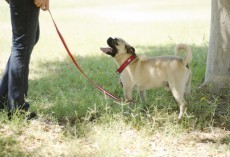Yuck! Who wants to deal with getting a tick off of their dog? Before you get completely grossed out remember that your pup's needs come first. You need to stay calm so that he'll stay calm too, which might mean you need to use the help of a friend or significant other (if available). Then follow these steps:
Ticks are a major problem for both dogs and humans because of the dangerous diseases they carry and transmit.
It can take between 24 and 48 hours for a burrowed tick to infect its host, so removing it quickly is critical.
If you have inspected your dog and found a tick burrowed on your dog's skin, follow these steps to remove the tick safely.Do not use petroleum jelly, rubbing alcohol, oils /butter, paraffin, nail polish remover or any liquid solutions to stimulate the tick to release its grip.
There are really only two safe ways to remove an attached tick: with fine-tipped (precision) tweezers or with a tick-removal tool
To begin, you will need the following items:
• Pair of latex or rubber gloves
• Clean pair of fine-tipped (precision) tweezers or a commercial tick remover, such as the Tick Twister
• Antiseptic
• Isopropyl alcohol
• small container or zip-lock bagRemove the tick. Wear latex or rubber gloves while removing the tick to avoid contact with your skin.
If using tweezers:
1. Gently grasp the tick as close to your dog’s skin as possible.
2. Pull outward in a straight, steady motion.
3. Make sure the entire tick is removed.If you're using a tick remover:
1. Gently press the remover against your dog's skin near the tick.
2. Slide the notch of the remover under the tick.
3. Continue sliding the remover until the tick is caught in the small end of the notch and is pulled free.Sterlize the bite site. Clean the bite site on your dog's skin with antiseptic and make sure to clean your tweezers or tick remover with isopropyl alcohol.
Monitor your dog. If you are unsure when your dog may have been bitten, you may want to take your dog to a veterinarian for a check up.Keep an eye on the bite area for infection. If your dog's skin remains irritated or infected, make an appointment with your veterinarian.
If you removed the tick(s) correctly your pup should be fine, as contracting Lyme's Disease is quite rare. But it's still important to take care of your pooch so that he'll be healthy and plus, if you encounter ticks again in the future you'll know how to deal with them. For additional tips on successfully removing ticks you can head over to Dog Heirs.










